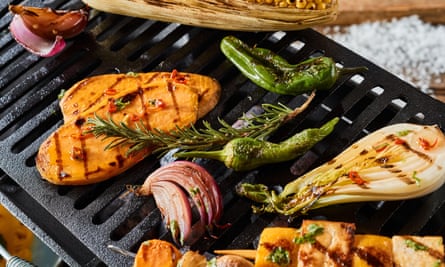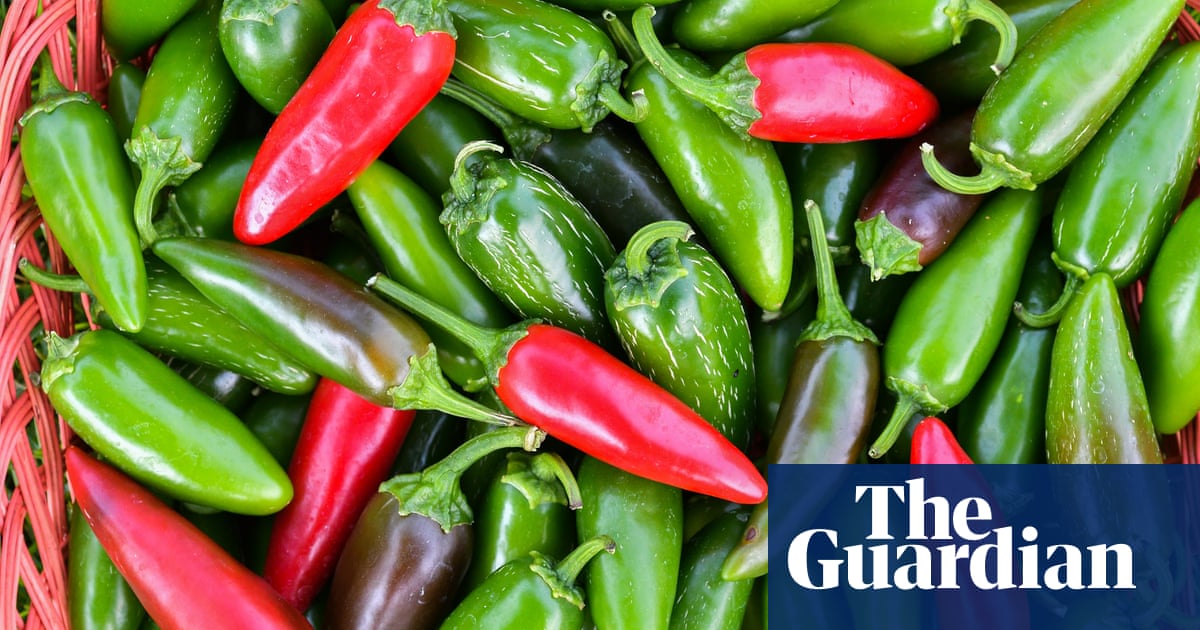The jalapeño pepper has long been synonymous with spiciness – but if you’ve perceived a decline in its power, it’s not your imagination. Some jalapeños truly are getting less spicy, thanks to shadowy forces.
The dining critic Brian Reinhart blew the whole thing wide open in a piece in the Dallas-area publication D Magazine last year. Last week, it caught the eye of a health writer, Timothy Faust, who posted: “Big Ag actually made jalapeños less spicy – you’re not going nuts.” He’d clearly struck a chord: “Heat lovers are fired up over ‘diabolical’ scheme,” said the New York Post. “What the jal? Jalapeños aren’t hot any more,” lamented the Food Institute. “I have tasted these blandapeños. They are an abomination,” tweeted the poet DA Powell.
“The long-term ‘de-spicification’ of the jalapeño is a deliberate choice, not the product of a bad season of weather,” Reinhart wrote. In short, most jalapeños are sent to factories to be used in prepared foods such as salsas, chips and sausages. The companies making these products want control over their products’ spice levels – and control is easier to achieve if the jalapeños are mild.
That’s because flavor and spiciness are two different things, says José C Marmolejo, a food writer who is Mexico’s representative to the World Chilli Alliance. Spiciness comes from a substance in the peppers known as capsaicin, which our bodies perceive as heat. Flavor, he explains, is what would be left if you took it out.
Companies can toss mild jalapeños into their recipes for flavor without worrying about spiciness. Then they can stoke the fire to the desired level by adding the spice itself: a pepper extract called oleoresin capsicum, which Reinhart describes as “pure heat”.
“It was a really big deal when breeders [told the industry], ‘Hey, look, I have a low-heat jalapeño,’ and then a low-heat but high-flavor jalapeño,” says Reinhart’s key source in the investigation. “That kind of became the big demand for jalapeños – low heat jalapeños – because most of them are used for processing and cooking. [Producers] want to start with jalapeños and add oleoresin capsicum.”
Reinhart’s source, Stephanie Walker, clearly knows her peppers: she’s on the advisory board of New Mexico University’s Chile Pepper Institute and was chair of last year’s New Mexico Chile Conference. New Mexico might be called the chilli state: it produced more than 60% of US chillis in 2021, and last year, it became the first state with an (extremely specific) official state aroma: “green chillis roasting in the fall”.
A key culprit in the de-spicification conspiracy, however, comes from one state over. It’s known as the Tam II, and it’s a type of jalapeño developed at Texas A&M University – hence the acronym – that’s very mild. It became a hit after emerging two decades ago, and its genes entered “the general jalapeño pool”, making the whole thing milder, Reinhart writes.
 View image in fullscreen
View image in fullscreen
For big companies, it’s all about standardization, says Marmolejo, who likens the phenomenon to “the McDonald’s concept that every burger has stayed the same everywhere”. As a former manufacturer of salsa and other chilli products, he ran into the issue himself. But he took a different approach to solving it: making his foods in big batches. “You might get some chillis that are spicy and others that are not,” he says. But mix big quantities, and things tend to even out: “It’s probability.”
“I’m into natural processes and flavors, and so I wouldn’t trust a company that would put additives in, even if it’s capsaicin,” Marmolejo says.
skip past newsletter promotionSign up to Feast
Recipes from all our star cooks, seasonal eating ideas and restaurant reviews. Get our best food writing every week
after newsletter promotion
In fact, the extract itself is pretty unappealing, says Dave DeWitt, a food historian and chilli expert who collaborated with Marmolejo on a cookbook Reinhart cites. “I’ve seen buckets of it. It’s nasty, nasty, nasty,” he says. “It’s a chemical more than a food, I think.” But he acknowledges it makes business sense for companies to use it, given concerns over standardization and the cost of peppers.
Even if some jalapeños are getting weaker, pepper fans shouldn’t worry: they still have plenty of options. “You want a hot jalapeño, they are there,” Marmolejo says, highlighting those grown in the Mexican states of Chihuahua and Veracruz.
He strongly cautions against any generalization about a decline in spiciness, given the many different varieties of jalapeños – there are dozens, according to DeWitt. Reinhart points, for instance, to the mitla variety, which can hit 8,000 on the Scoville scale of spiciness, compared with 1,080 for some Tam peppers. Customers looking for spicier options might want to check the source of their peppers: jalapeños grown in Mexico may be spicier, and broadly speaking, smaller peppers are often hotter, DeWitt says.
And there are plenty of non-jalapeño chillis to choose from if you’re looking for heat. “Habaneros have been very popular for the last 30 years in the states,” says Marmolejo. “They are probably my favorite fresh chilli pepper. The aroma is unmistakable.”
∎
